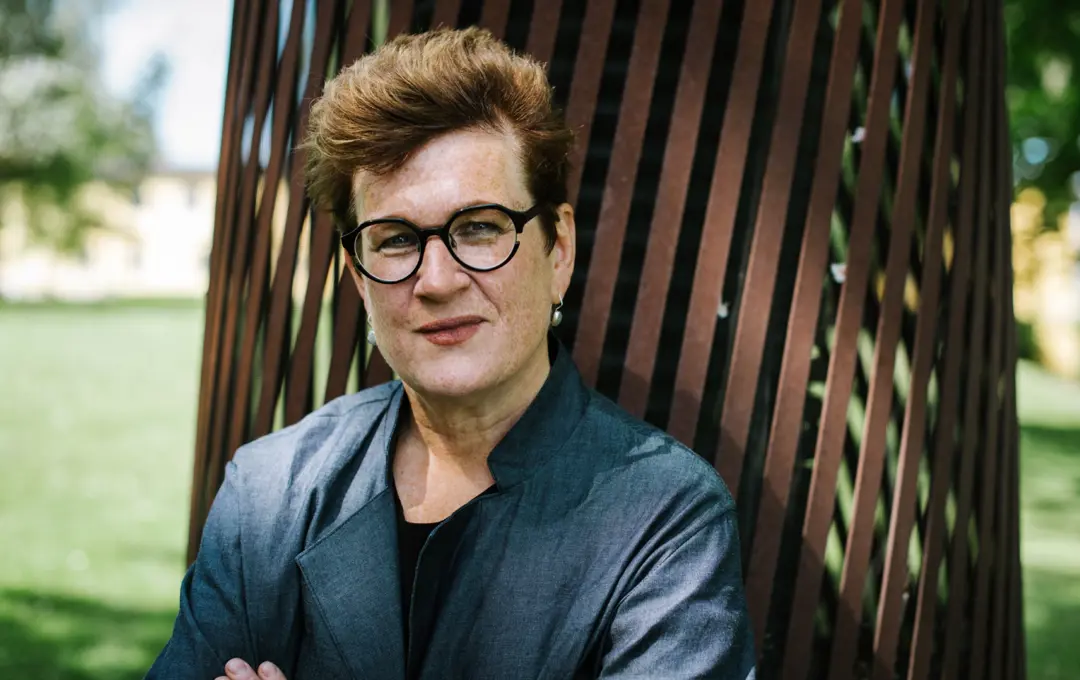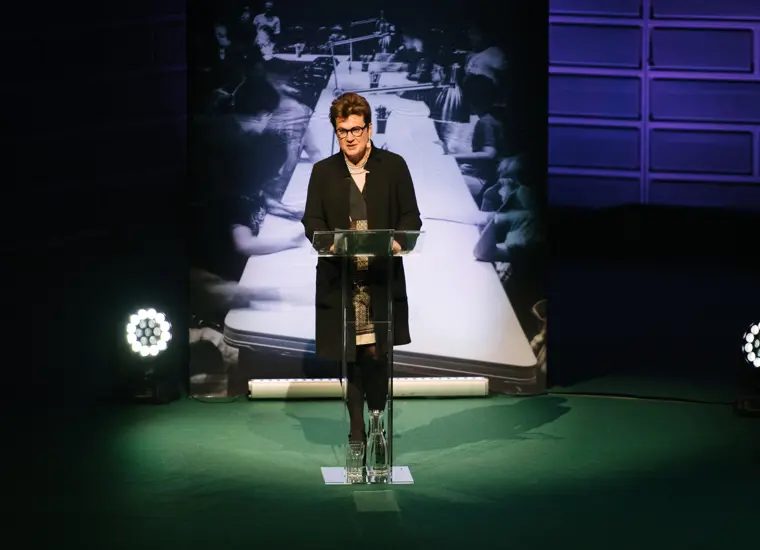Leaves no reader unmoved
Meg Rosoff is an American author based in London. She debuted in 2004 with the dystopic young adult novel How I Live Now which became an instant success. Since then she has written several novels centered around unforgettable characters living in thorny borderlands between childhood and adult life.
 Photo: Stefan Tell
Photo: Stefan TellQuick facts
The jury’s motivation
Meg Rosoff's young adult novels speak to the emotions as well as the intellect. In sparkling prose, she writes about the search for meaning and identity in a peculiar and bizarre world. Her brave and humorous stories are one-of-a-kind. She leaves no reader unmoved.
Author Meg Rosoff was born in in Boston, United States in 1956. She has lived and worked in London for many years, and made her authorial debut in 2004 with the dystopian YA novel How I Live Now, which became an immediate success. Since then she has written six more YA novels, several picture books, and a novel for adults. Her collected body of work is richly varied and profoundly affecting for readers of all ages.
Rosoff writes about young people in the borderlands between childhood and adult life who face difficult trials in their quests to find themselves. At times they are pushed to the brink of the unbearable and beyond. Her protagonists battle questions of identity and sexuality and are thrown involuntarily into chaotic situations. Like Astrid Lindgren, Rosoff empathizes completely with young people and is utterly loyal to them. The adult world, when it appears, remains on the periphery. She uses concrete, vibrant language, whether she is describing a landscape, a piece of clothing, or the groceries in the pantry. She infuses darkness with humor to produce stylistic masterpieces.
In What I Was (2007), questions of body, identity, and gender, the confusions of falling in love, and the desire and sexuality of the young all come to a head as the narrator sets out to find himself and choose a path different from the one laid out for him by the adult world.
At times, as in Just in Case (2006), reality and fantasy almost merge, so that we are hard-pressed to say what is ”really” happening. In There is no Dog (2011), things get truly crazy when a hormonal teen is given the job of the great Creator.
Meg Rosoff is the recipient of numerous prizes, including Guardian Children’s Fiction Prize, Carnegie Medal and Deutsche Jugendliteraturpreis. Her books have been translated into more than 20 languages and she became Fellow of the Royal Society of Literature in 2014.
The phone call from the jury
Each one of her books is unique
This text was written in 2016 by members of the award jury.
Meg Rosoff’s YA novels form a suite of existential dramas in which values and norms, ideas and preconceptions are subjected to constant challenge and change. Rosoff’s work is transformative in the highest degree. She treats the question of “what if?” as both reality and thought experiment. Among YA authors, Rosoff stands out for the way she writes about young people: with respect, but also with critical, intimate scrutiny and much humor.
Rosoff’s first novel, How I Live Now (2004), is an unsettling depiction of war and love from a young adult’s point of view. It is both a dystopian action story and a novel about a provocative love affair between two young cousins – one of whom is only fourteen years old – that bursts the traditional bounds of the YA genre. Fifteen-year-old Daisy from New York is sent to visit relatives in England for the summer. When a war suddenly breaks out, she and her cousins must fend for themselves without adult assistance. The madness and chaos of war leave little time for reflection; or as Daisy says, “If you haven’t been in a war and are wondering how long it takes to get used to losing everything you think you need or love, I can tell you the answer is no time at all.” How do you feel alive when your world is falling apart? The novel offers no easy answers. Daisy pays a high price for her survival, but she also reaches new insights about herself and the things worth living for.
How I Live Now enjoyed tremendous success and had a significant impact on the development of the YA novel. Rosoff’s body of work now includes seven YA novels and several picture books as well as a novel for adults. The books that have followed her debut are all very different from one another, but all are surprising, radical, and emotionally charged. In sparkling prose, Rosoff paints unforgettable characters living in thorny borderlands between childhood and adult life. Their circumstances at times are difficult, even horrifying, but their stories are also shot through with love both fragile and beautiful, with empathy, and with unswerving loyalty.
Rosoff’s second novel, Just in Case (2006), which won the Carnegie Medal, is about another lost teen. Fifteen-year-old David Case is struggling with his newfound insight into his own mortality. He decides to cheat Fate by becoming a different person. He changes his name to Justin and adopts a whole new lifestyle, but in the process he loses himself. With both humor and heartache, Rosoff traces the ways in which the world misunderstands Justin’s crisis of identity and tries to make him into someone he is not. The stream-of-consciousness narration – which mirrors the twists and turns in Justin’s brain – holds readers in an iron grip. Like the protagonist Holden in Salinger’s classic coming-of-age novel, The Catcher in the Rye (1951), Justin clearly struggles with his perception of reality: he can hear the voice of Fate, and he keeps company with an imaginary dog.
Body, identity and gender issues and themes of loss and memory are all central to Rosoff’s work. Her third novel, What I Was (2007), takes the form of a retrospective personal history. It is a complex tale of friendship, love, and liberation, of reflections on a wounded past, and of difficult crossroads in life. The story takes place in the 1960s in a coastal landscape that is slowly sinking beneath the sea: a suggestive setting that mirrors the transgression of boundaries staged in the novel. In this barren world, we meet a sixteen-year-old narrator who has been sent off to a school for boys after being expelled from two previous boarding schools. His father demands that he clean up his act and become a man, but being a boy who measures up to the middle-class ideals of his family and school – popular, smart, athletic – is hard enough. Chafing at the future that has been laid out for him, he finds an escape when he meets Finn, a boy who lives alone in a shack by the ocean. In Finn he sees the person he would like to be, but his all-absorbing love has dramatic consequences and blinds him to who Finn really is.
Rosoff skillfully varies narrative technique and perspective. She writes in familiar literary genres and narrative traditions, but adapts them freely for her own purposes. A clear example is the historical novel The Bride’s Farewell (2009). Set in the rolling English countryside around Salisbury Plain, it recalls English novels of the nineteenth century by authors such as Thomas Hardy, but Rosoff uses her historical setting to tell a highly topical, poignant story. Her protagonist, Pell, defies convention, running from a future as a poor married woman who will spend her days in toil and childbearing, and choosing a life lived on her own terms. Yet it is no easy, romanticized picture of women’s liberation that Rosoff paints. Pell’s choice leads to hard sacrifices and she must fight for the people she loves.
There is no Dog (2011) challenges readers anew. In this theological satire, God is a hormonal, emotionally volatile teenager named Bob. Of all his creations, Bob likes cute girls the best. The only problem is that every time he falls in love, the Earth is pummeled by natural disasters that mirror his emotional turmoil. On Earth, Lucy lives blissfully unaware of Bob’s existence until he catches sight of her and environmental catastrophe ensues. Here, Rosoff gives her sense of humor free rein, introducing a remarkable cast of characters ranging from Bob’s excellent but despairing assistant, Mr. B, to a strange animal named Eck. Rosoff writes about the confusions of falling in love and young adult desire and sexuality with no holds barred. Our world may be filled with chaos and catastrophe, but it can still hold both joy and miracles.
Rosoff is an acute observer of psychology. The novel Picture me Gone (2013) juxtaposes the characters of Mila, her father Gil, and Gil’s missing friend, Matthew. Matthew is a Godot character, constantly discussed but infinitely elusive. Picture me Gone is both a philosophical whodunit, where the mystery consists in our (in)ability to understand one another, and a description of how reality and our perceptions of it can change. Mila has a special sensitivity to mood and an ability to read the thoughts of the people around her. The complexity of adulthood and a betrayal by the adults in her life affect her powerfully. It hurts, but her realization that things are not always as they appear deepens her understanding of the compound nature of friendship and love.
In Rosoff’s books, the natural and supernatural overlap and merge. The boundaries between humans and animals can also blur. Innumerable dogs appear: imaginary, as in Just in Case, or real, as in her latest adult novel, Jonathan Unleashed (2016), in which a young adult protagonist finds meaning and purpose by caring for his brother’s dogs. Jonathan is clueless about adult life, but the dogs give him a push in the right direction. In other books, characters see the world through animal eyes, as when Justin, for one crucial moment, becomes a rabbit. Rosoff also pays tribute to the strong and loving bonds that can form between human and animal. Two dogs and a goat follow Daisy and her cousins. Pell loves and understands horses. Mila is named after a dog. The theme is taken to the extreme in Vamoose! (2010), later republished as Moose Baby (2013), a novella about a teen pregnancy in which Jess and Nick must not only cope with their unplanned parenthood but also come to terms with the fact that their new baby is a 10 kilo moose calf.
Rosoff writes with naked honesty about the search for meaning and identity in a world that is peculiar, full of contradictions, and sometimes frankly bizarre. She moves freely from one existential question, one gender, one age group to another. Breakdowns and psychoses are subtly portrayed. Each one of her books is unique, and all of her work speaks to both the emotions and the intellect. Her books combine passion, philosophical depth, and breakneck plotting to leave no reader unmoved.
Meg Rosoff studied at Harvard University and at St. Martin’s School of Art and Design in London. Prior to her authorial debut at the age of 47, she worked in the publishing and advertising industries. She was born in Boston, United States in 1956, but has made her home in London for many years. Her books have been translated into more than 20 languages and she has received numerous awards. She became Fellow of the Royal Society of Literature in 2014.
Although I'm 59 years old I am still an adolescent in my heart. And I think we all are.

Highlights from the Award Ceremony
On May 30, Meg Rosoff received the 2016 Astrid Lindgren Memorial Award during a ceremony at the Concert Hall in Stockholm. In addition to the prize money of five million SEK, Rosoff also received a diploma which was presented by the Minister of Culture and Democracy Alice Bah Kuhnke.
Video and photos from the award ceremony
Discover our laureates
The Astrid Lindgren Memorial Award is awarded to authors, illustrators and narrators, but also to people or organizations that work to promote reading.
Find out more about the laureates
Children have the right to great stories
To lose yourself in a story is to find yourself in the grip of an irresistible power. A power that provokes thought, unlocks language and allows the imagination to roam free. The Astrid Lindgren Memorial Award was created in 2002 by the Swedish government to promote every child’s right to great stories.
Find out more about the award